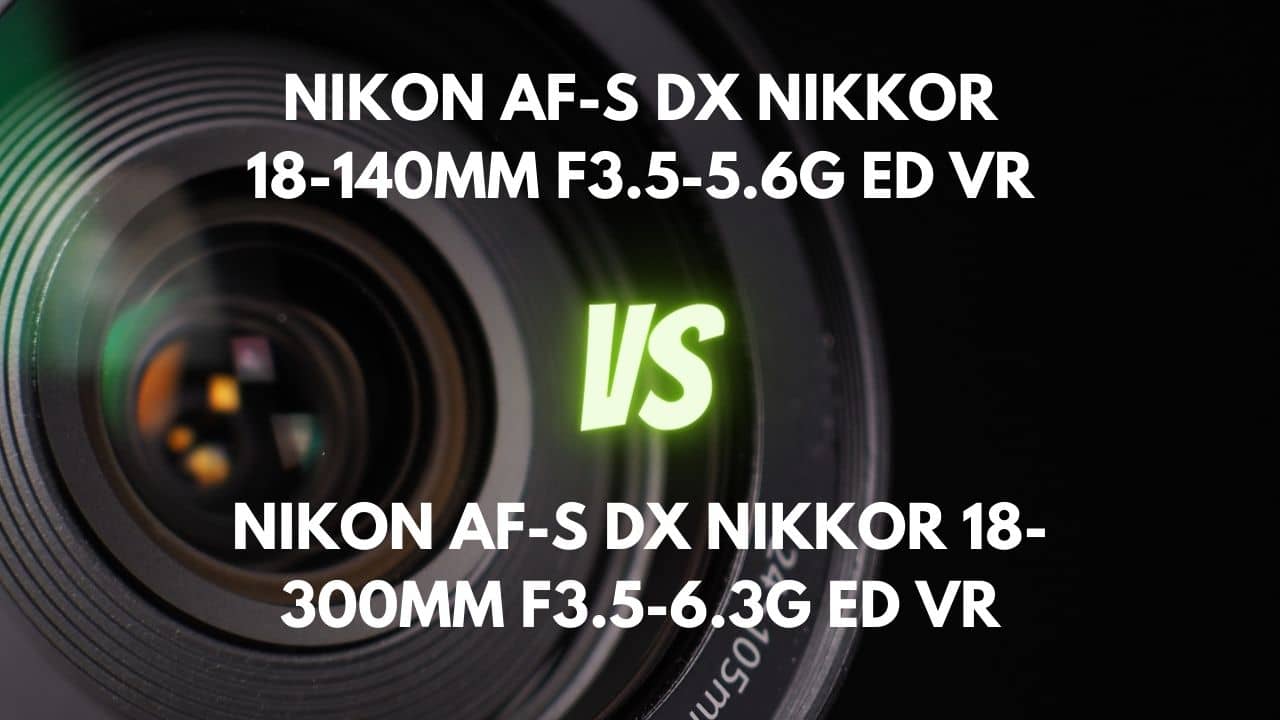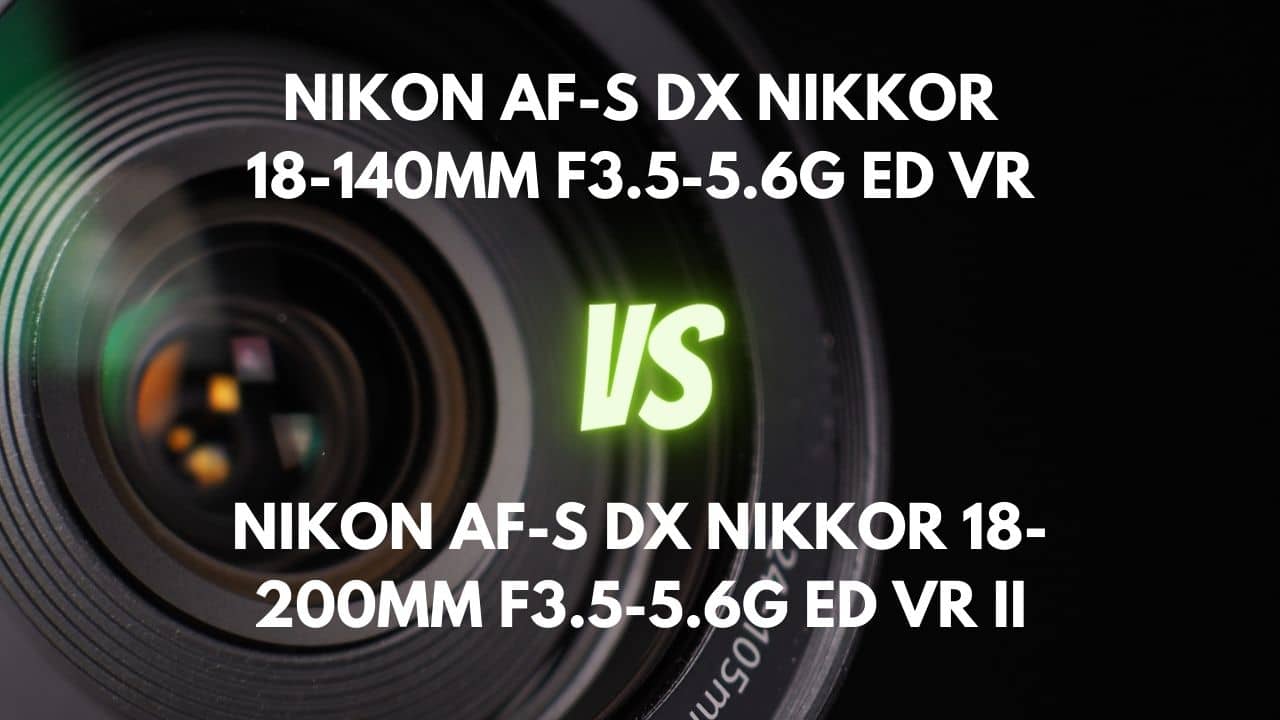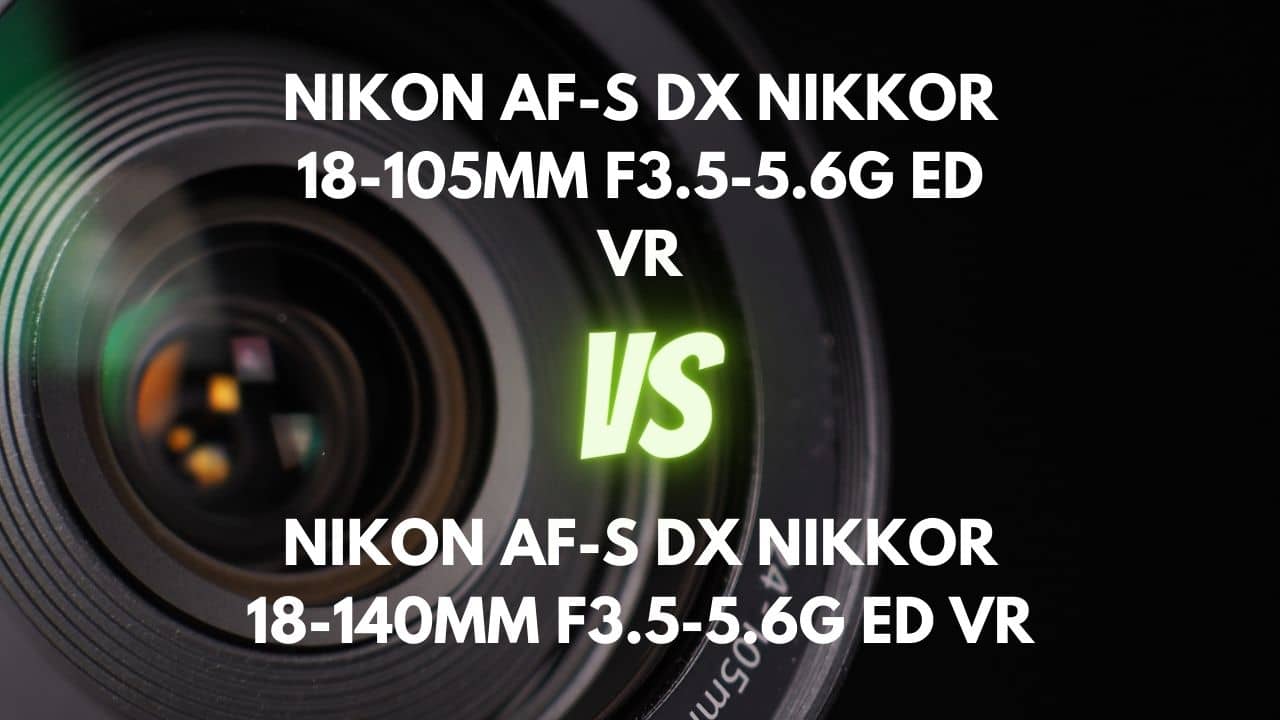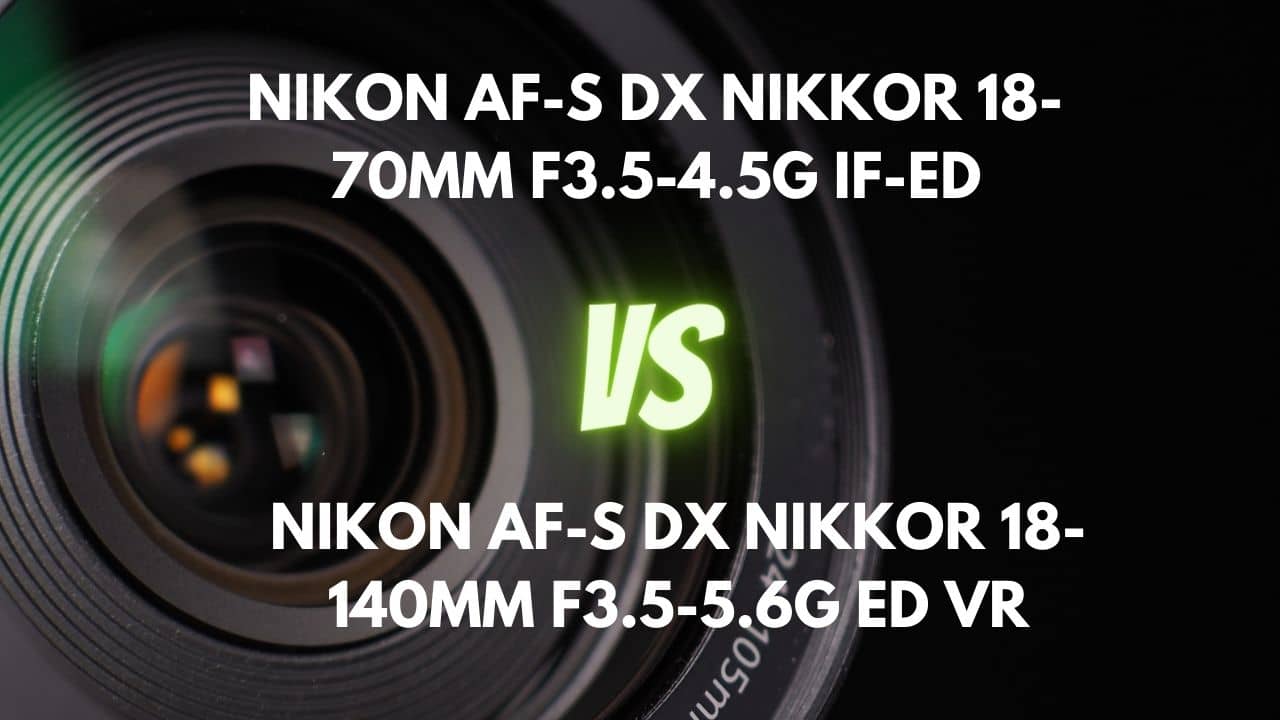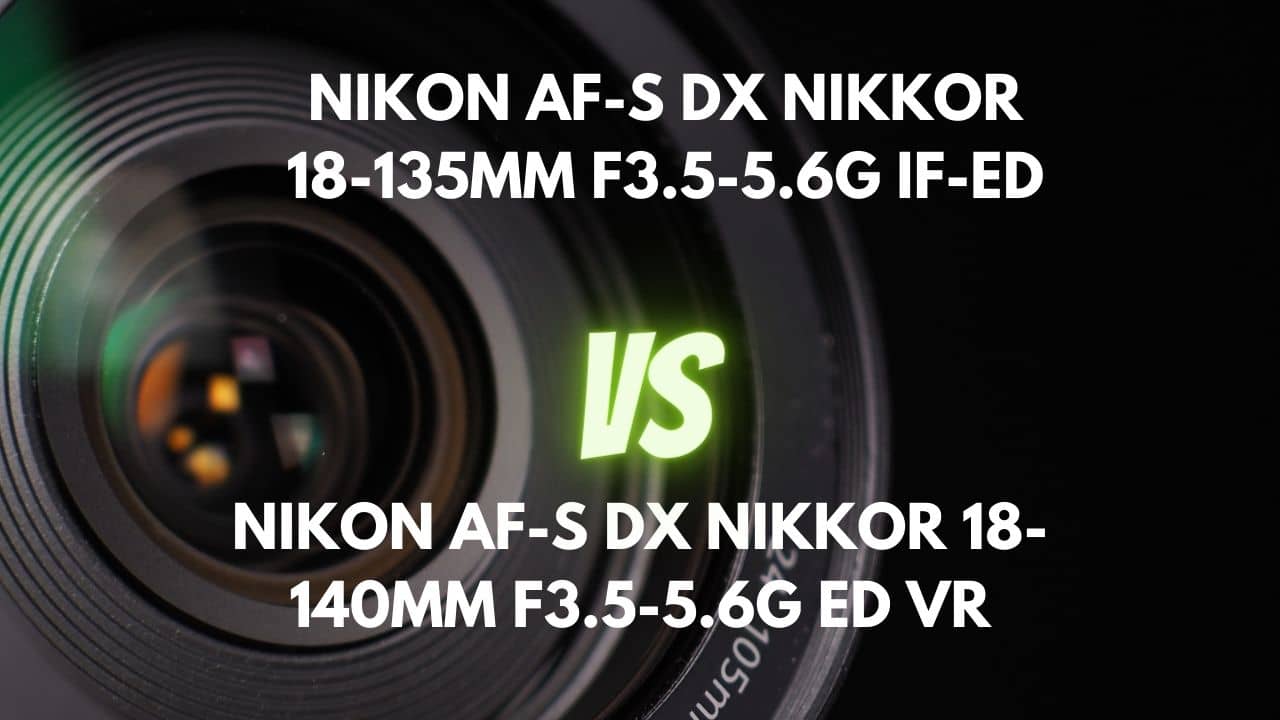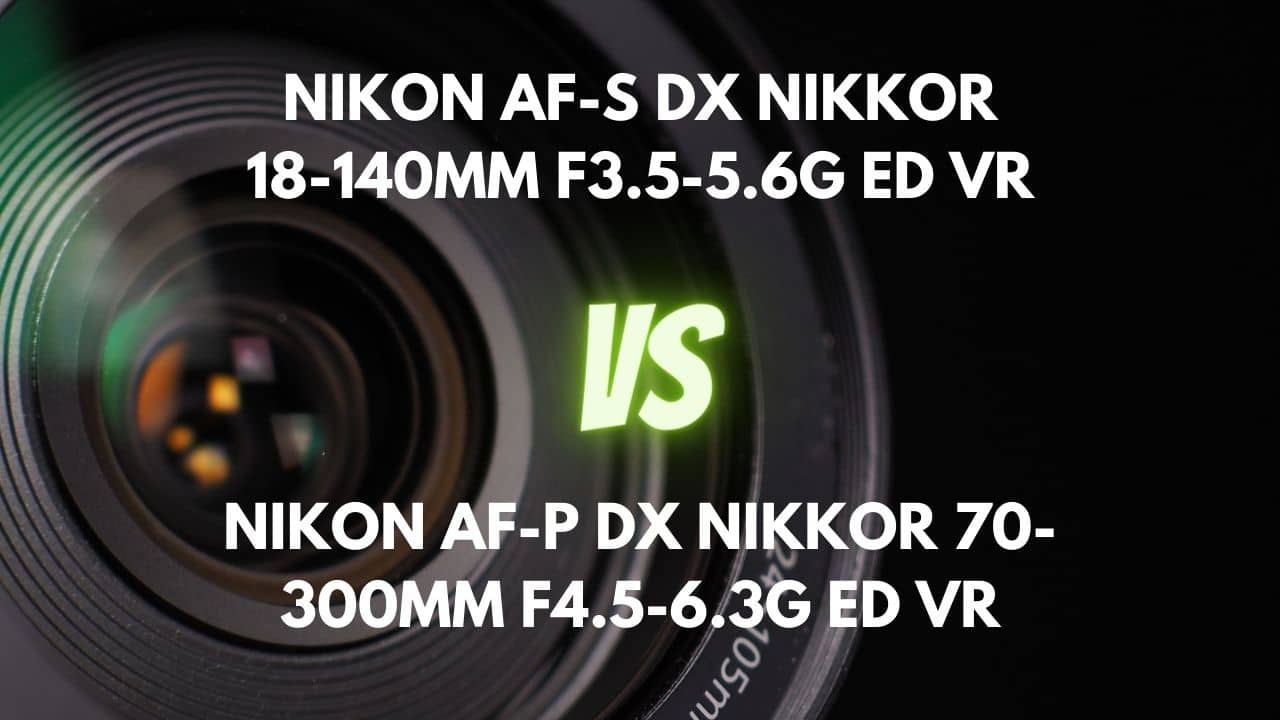Are you a passionate photographer looking to capture stunning images across various genres, but can’t decide between the Nikon DX 16-85mm f/3.5-5.6 and Nikon DX 18-140mm f/3.5-5.6? Look no further!
In this comprehensive comparison, we delve into the nuances of these two popular lenses, exploring their strengths and weaknesses in different types of photography. Whether you’re an avid landscape enthusiast, a portrait aficionado, or a travel photography connoisseur, our side-by-side analysis will guide you in choosing the perfect lens that aligns with your artistic vision.
By examining key features such as focal length, build quality, weather sealing, sharpness, and more, we aim to offer valuable insights to help you make an informed decision.
So, get ready to elevate your photography game as we navigate the world of Nikon 16-85mm and 18-140mm lenses, uncovering the potential they hold for your creative journey.
Read on to discover which lens emerges as the ideal companion for your photographic endeavors!
Overview
| Nikon AF-S DX NIKKOR 16-85mm F3.5-5.6G ED VR | Nikon AF-S DX NIKKOR 18-140mm F3.5-5.6G ED VR | |
|---|---|---|
| Max Aperture | F3.5-5.6 | F3.5-5.6 |
| Aperture Type | Variable | Variable |
| Focal Range (mm) | 16-85 | 18-140 |
| Max Format | APS-C / DX | APS-C / DX |
| Zoom Ratio (X) | 5.3 | 7.8 |
The Nikon DX 16-85mm f/3.5-5.6 has a focal range of 16-85mm and a maximum aperture of f/3.5-5.6. It features a variable aperture type and a 5.3x zoom ratio. This lens is suitable for a wide range of photography genres, including landscapes, architecture, and travel photography. Its wider focal length of 16mm allows for capturing expansive scenes, while the 85mm focal length provides versatility for various subjects. However, its aperture range might not be ideal for low light situations or creating a shallow depth of field, particularly at longer focal lengths.
On the other hand, the Nikon DX 18-140mm f/3.5-5.6 has a broader focal range of 18-140mm and shares the same maximum aperture of f/3.5-5.6. It also features a variable aperture type and a higher zoom ratio of 7.8x. This lens is more versatile, covering a wider range of focal lengths, making it suitable for various photography genres like travel, events, and sports photography. However, it has a similar limitation in low light situations and achieving a shallow depth of field at longer focal lengths due to its aperture range.
The APS-C/DX camera format is compatible with both lenses, and neither of them have a set aperture, which can affect the ability to capture images in low light and control depth of field. Nonetheless, they cater to different photography needs due to their focal range and zoom ratios.
In conclusion, the 16-85mm lens offers a better wide-angle performance, making it an excellent choice for landscape and architecture photography. The 18-140mm lens, however, provides greater versatility and a broader focal range, which makes it more suitable for photographers who require flexibility in various situations. While neither lens is superior in every aspect, your choice will ultimately depend on your specific needs, preferences, and the genres of photography you are most interested in.
Design and Ease of Use
| Nikon AF-S DX NIKKOR 16-85mm F3.5-5.6G ED VR | Nikon AF-S DX NIKKOR 18-140mm F3.5-5.6G ED VR | |
|---|---|---|
| Diameter x Length (mm) | ⌀72×85mm | ⌀78×97mm |
| Weight (gr) | 485 | 490 |
| Filter Thread (mm) | 67 | 67 |
| Weather Sealing | No | No |
| Zoom Method | Rotary (extending) | Rotary (extending) |
| Distance Scale | Yes | No |
| DoF Scale | No | No |
| Hood Supplied | Yes | No |
| Hood Code | HB-39 | HB-32 |
The Nikon DX 16-85mm f/3.5-5.6 has dimensions of ⌀72×85mm and a weight of 485 grams. This lens is relatively compact and lightweight, making it portable and easy to carry around during travel or long walks.
Its smaller size and lighter weight also contribute to better balance when attached to a camera, making it more comfortable to handle during extended shoots. Additionally, the lens’s discreetness can be advantageous in situations like street photography, where blending in is essential.
However, the 16-85mm lens utilizes an extending rotary zoom method, which means the lens physically extends when zooming in or out. This could make it harder to handle and more challenging to weather-seal, protecting it from dust and moisture.
In comparison, the Nikon DX 18-140mm f/3.5-5.6 has slightly larger dimensions of ⌀78×97mm and a marginally heavier weight of 490 grams. While this lens is still reasonably portable, its larger size and weight may affect the camera’s overall balance, making it feel more front-heavy and potentially more challenging to handle during long shoots. Like the 16-85mm lens, the 18-140mm lens also uses an extending rotary zoom method, which comes with similar handling and weather-sealing concerns.
In conclusion, both lenses have their merits in terms of dimensions and weight, with the 16-85mm lens being slightly more compact and lightweight. However, neither lens has a significant advantage over the other in this regard.
Lens Mount and Barrel
The Nikon DX 16-85mm f/3.5-5.6 features a metal lens mount resembling Nikon’s standard dull chromed brass, offering durability and a professional appearance. A substantial weather sealing gasket surrounds the mount, providing enhanced protection against moisture and dust.
The lens barrel is constructed primarily from high-quality plastics, ensuring a lightweight yet sturdy design. Rubberized zoom and focus rings offer excellent grip, and the ergonomic bevel makes handling comfortable. Although the lens barrel extends approximately 42mm when zooming from wide-angle to maximum telephoto, it remains compact and well-balanced on various camera bodies.
In contrast, the Nikon DX 18-140mm f/3.5-5.6 has a metal lens mount but lacks weather sealing, making it more susceptible to moisture and dust. Its lens barrel is made of polycarbonate plastic with a metal mounting plate, striking a balance between weight and durability. The zoom and manual focus rings feature textured rubber grips that provide a comfortable grip.
When zooming from 18mm to 140mm, the lens extends slightly over 50mm, and the inner barrel moves without any noticeable looseness. However, as the focal length is adjusted, the rear group of elements shifts back and forth within a range of about 3cm.
Considering the lens mount and barrel, the 16-85mm lens proves superior due to its weather-sealed metal mount, providing better protection and a more professional feel. Its high-quality plastic construction ensures a lightweight and sturdy design, while the rubberized rings and ergonomic bevel enhance handling.
Although the 18-140mm lens has some advantages, such as a metal mounting plate and textured rubber grips, its lack of weather sealing and greater extension when zooming make it less desirable in comparison.
Weather Sealing
The Nikon DX 16-85mm f/3.5-5.6 features a metal lens mount with a substantial weather sealing gasket around the edge, offering a robust barrier against dust and moisture. Although the lens provides some level of weather sealing, it might not be as protective as lenses with more extensive sealing features. This level of weather sealing is suitable for photographers who occasionally shoot in challenging environments or varying weather conditions.
Conversely, the Nikon DX 18-140mm f/3.5-5.6 does not have any weather sealing, as there is no gasket at the lens mount, nor are there any internal seals at the rings, switches, or front of the barrel. Moreover, the front element is not coated with fluorine. Consequently, this lens is not suitable for use in harsh weather conditions or environments with a high amount of moisture and dust.
Considering the weather sealing features, the 16-85mm lens is superior, providing a higher level of protection against dust, moisture, and light water splashes. This makes it more suitable for outdoor photography in various conditions. The 18-140mm lens, lacking weather sealing, would require additional protection in inclement weather and may not be ideal for photographers frequently shooting in challenging environments. Choosing the 16-85mm lens with its weather sealing can offer you peace of mind and ensure the durability of your equipment when shooting in diverse conditions.
Rings
The Nikon DX 16-85mm f/3.5-5.6 features 2 rubber-ribbed rings for zoom and focus control, offering excellent grip and comfortable handling. The zoom control rotates about 90 degrees, providing a firm and smooth experience without any zoom creep, while the focus control rotates about 130 degrees for easy manual focusing. However, the zoom ring stiffens a bit beyond 50mm. The lens includes a windowed distance scale but lacks a depth-of-field indicator and extension lock switch on the zoom ring.
In contrast, the Nikon DX 18-140mm f/3.5-5.6 sports 2 rings: a zoom ring and a focusing ring. The zoom ring, covered in a thick, textured rubber grip band, is located near the front of the lens and occupies most of the barrel. The focusing ring is positioned behind the zoom ring, and although narrower, it still features a ridged rubber grip band. The zoom ring offers a nice resistance and is well-damped, while the focusing ring has a long throw but limited tactile feedback. Furthermore, the lens is also missing a windowed distance scale, a depth-of-field indicator, and an extension lock switch on the zoom ring.
Comparing the two lenses, the 16-85mm lens offers superior ergonomics and control in terms of ring design, with its rubber-ribbed rings and smooth yet firm zoom control. The 18-140mm lens, while providing a comfortable grip, lacks the same level of tactile feedback and precision.
Switches/Buttons
The Nikon DX 16-85mm f/3.5-5.6 is equipped with 3 switches/buttons, offering versatility and ease of use. One switch activates and deactivates autofocus with the option of manual override (AF/MF switch), another activates and deactivates Vibration Reduction with two modes to choose from (IS switch), and the last sets the VR mode sensitivity level (normal or active).
The well-designed switches make it simple to switch between different modes when necessary. Additionally, the AF/MF switch is labeled as “M/A M,” which allows autofocus with instant manual override by turning the focus ring at any time, further enhancing the user-friendliness of the lens.
On the other hand, the Nikon DX 18-140mm f/3.5-5.6 features 2 control switches located on its left side. One switch enables or disables autofocus (A or M), while the other switch enables or disables vibration reduction (ON or OFF). The aperture is controlled via a mechanical lever.
Comparing the two lenses, the 16-85mm lens has a more comprehensive and well-thought-out switch/button design, providing greater versatility and convenience for the photographer. The additional switch for VR mode sensitivity level and the instant manual override option in autofocus make the 16-85mm lens a superior choice in terms of switches/buttons, allowing for a more seamless and user-friendly shooting experience.
Filter Thread
The Nikon DX 16-85mm f/3.5-5.6 features a 67mm plastic filter thread. The front element remains stationary during focusing and zooming, making it convenient to use with polarizers and graduated filters. In addition, the lens exhibits no vignetting even when using a double-stack of filters that are 11mm thick, excluding the rear threads.
The Nikon DX 18-140mm f/3.5-5.6 has a metal filter thread, also 67mm in size. Like the 16-85mm lens, the front element does not rotate during focusing or zooming, which is ideal for using filters such as graduated neutral density filters and polarizers. Positioned just behind the filter ring, the front element of the lens is quite flat, and there is a small marker on the outer edge of the filter ring that serves as a guide for attaching the bayonet-style lens hood, which is sold separately.
Comparing the two lenses, both share the same 67mm filter thread size, making them equally compatible with filters and accessories. However, the 18-140mm lens has a metal filter thread, offering greater durability and longevity compared to the plastic filter thread of the 16-85mm lens. This makes the 18-140mm lens a superior choice in terms of filter thread material, providing a more robust option for photographers who frequently use filters and change attachments.
Lens Hood
The Nikon DX 16-85mm f/3.5-5.6 includes a petal-shaped lens hood in the package. It is reasonably deep and made of lightweight plastic material. This hood effectively reduces extraneous light, preventing flare and maintaining contrast in images. However, at 85mm, it is not as effective at blocking stray light as it is at wider angles. The lens hood fits firmly on the lens and can be smoothly rotated.
Conversely, the Nikon DX 18-140mm f/3.5-5.6 does not come with a lens hood included in the package. Instead, the lens hood is an optional accessory that is available for purchase separately. This plastic, petal-shaped hood has a bayonet mount and can be reversed for storage. The hood is designed with an ergonomic bevel and can be smoothly rotated. Its primary purpose is to prevent lens flare and protect the front element of the lens from impacts.
Comparing the two lenses, the 16-85mm lens has a superior lens hood offering as it comes included with the lens. This saves the user from the additional cost and effort of purchasing a separate lens hood. Both lens hoods are effective in reducing flare and protecting the front element, but the 16-85mm lens hood’s inclusion in the package gives it an edge over the 18-140mm lens in this aspect.
Focusing and Optical Stabilization
| Nikon AF-S DX NIKKOR 16-85mm F3.5-5.6G ED VR | Nikon AF-S DX NIKKOR 18-140mm F3.5-5.6G ED VR | |
|---|---|---|
| Autofocus | Yes | Yes |
| AF Motor | Silent Wave Motor | Silent Wave Motor |
| Rotating Front Element | Does not rotate on focusing | Does not rotate on focusing |
| Min Focus Distance | 0.38m | 0.45m |
| Max Magnification (X) | 0.22 | 0.23 |
| Full-Time Manual Focus | Yes | Yes |
| Focus Method | Internal | Internal |
Focusing Performance
The Nikon DX 16-85mm f/3.5-5.6 features an AF-S motor that delivers fast and near-silent autofocus operations. Though the motor operates accurately, it only offers average speed and produces a quiet whirring sound. The ultrasonic motor allows manual focus override by turning the focus ring at any time.
The lens has an internal focusing design, ensuring a constant length regardless of the zoom or focus settings, while the manual focus action is smooth and precise. The initial autofocus acquisition speed is reasonable, but the lens displays significant focus breathing and may produce an audible squeak during focusing.
In contrast, the Nikon DX 18-140mm f/3.5-5.6 has an ultrasonic Silent Wave Motor, which results in fast and almost silent autofocus operation that is also remarkably quiet. This lens works well in single-servo autofocus and continuous autofocus modes. Additionally, the ultrasonic Silent Wave Motor enables manual focus override, allowing users to smoothly adjust the focus by turning the focus ring. This feature provides a seamless and intuitive focusing experience. Like the 16-85mm, it has an internally focusing design and exhibits focus breathing, especially at the long end of the zoom range.
Comparing the two lenses, the 18-140mm has a superior focusing performance due to its faster and quieter autofocus operation. While both lenses offer manual focus override and have an internally focusing design, the 18-140mm lens is better suited for situations where quick and silent autofocus is crucial, such as in sports, wildlife, or event photography.
Optical Stabilization
Equipped with second-generation optical stabilization (VR II), the Nikon DX 16-85mm f/3.5-5.6 enables users to capture sharp photos at shutter speeds up to 4 stops slower than the standard rule of thumb. The VR II system offers two modes, normal and active, with the latter providing increased sensitivity to camera movement. The VR system is effective in low-light situations and helps keep still shots sharper and video footage smoother, without making any audible noise during operation.
Conversely, the Nikon DX 18-140mm f/3.5-5.6 comes with Nikon’s vibration reduction (VR) technology, which effectively reduces camera shake by up to 4 f-stops when shooting handheld. The lens features a stabilization slider with two positions: on and off. When turned on, the built-in VR stabilization is highly effective, allowing photographers to capture sharp images while hand-holding the camera at slower shutter speeds, such as 1/15 second, when using the 140mm focal length. Users can expect roughly half of their shots to be sharp when using this technique.
Comparing the two lenses, both offer effective optical stabilization, allowing for up to 4 stops of compensation. However, the 16-85mm lens has the advantage of offering two VR modes, normal and active, providing more flexibility in handling camera shake. This makes the 16-85mm lens slightly superior in terms of optical stabilization, ensuring sharper still shots and smoother video footage in various situations.
Image Quality
| Nikon AF-S DX NIKKOR 16-85mm F3.5-5.6G ED VR | Nikon AF-S DX NIKKOR 18-140mm F3.5-5.6G ED VR | |
|---|---|---|
| Special Elements | 2x ED glass elements and 3x aspherical lens elements | 1 ED (extra-low dispersion) glass element, 1 aspherical lens element |
| Diaphragm Blades | 7 | 7 |
| Circular Aperture | Yes | No |
Aberration
When it comes to chromatic aberration, the Nikon DX 16-85mm f/3.5-5.6 delivers exceptional performance, with excellent control exhibited throughout the zoom range. At its worst, chromatic aberration is only visible at around 5/100ths of a percent of the frame height when using the telephoto end (85mm), and it’s virtually non-existent between 24mm and 70mm.
Thanks to the inclusion of 3 aspherical lens elements, the Nikon DX 16-85mm f/3.5-5.6 effectively controls both coma and spherical aberration, minimizing lens distortion. However, some field curvature in the extreme corners and a slight focus shift when stopping down may be noticeable at the widest focal length of 16mm due to residual spherical aberrations.
In contrast, the Nikon DX 18-140mm f/3.5-5.6 exhibits chromatic aberration, which is more noticeable in this model than previous Nikon offerings. Although the field curvature and focus shift may be noticeable at 16mm, they are generally not considered objectionable. In test images, there may be slight dark blue fringing visible around areas of high contrast in the corners of the frame. The lens delivers excellent coma performance, with no evidence of smeared blobs around bright points of light, even in the corners of the image.
In conclusion, the 16-85mm lens outperforms the 18-140mm lens in terms of aberration control, particularly in chromatic aberration.
Sharpness
The Nikon DX 16-85mm f/3.5-5.6 is consistently praised for its sharpness, delivering excellent results even at maximum aperture and in the center of the frame. The lens produces even sharpness across the frame, with only minor variations that may be noticeable when shooting special test subjects at full aperture and enlarging images to substantial sizes.
Overall, the corner sharpness of the lens is quite good, although there may be some minor softness when shooting wide open at 16mm or 85mm. However, stopping down to f/5.6 or f/8 results in excellent sharpness across the frame. The sharpest aperture will vary depending on the focal length, but generally speaking, peak performance is achieved at around f/5.6 or f/8.
Conversely, the Nikon DX 18-140mm f/3.5-5.6 delivers good sharpness performance, with center sharpness being particularly impressive at wider apertures and improving even further when stopping down to f/5.6 and beyond.
The lens’s corner sharpness can be slightly soft, particularly at wider angles, but stopping down to around f/8 can significantly improve it. The sharpest aperture will vary depending on the focal length, but generally speaking, f/8 and f/11 provide the best results. However, diffraction can become visible around f/8 and become a more significant issue at f/16 or smaller apertures.
In conclusion, the 16-85mm lens outshines the 18-140mm lens in terms of overall sharpness, providing more consistent performance across the frame and throughout the zoom range. Its superior sharpness makes it the preferred choice for photographers who prioritize image clarity and detail, whether shooting wide-angle landscapes or telephoto portraits.
Bokeh Quality
The bokeh quality of the Nikon DX 16-85mm f/3.5-5.6 is somewhat mixed. When shooting at 85mm f/5.6, the bokeh of the lens is acceptable for both highlights and general blur, although it is not particularly remarkable. However, when shooting at around 50mm f/5, the blur can be quite busy, with shape shadows and outlining effects around highlights that are not very pleasing, almost resembling a mirror lens. The bokeh may appear rather underdeveloped in typical scenes due to the relatively slow maximum aperture, and it can be rather harsh at 50mm.
In contrast, the Nikon DX 18-140mm f/3.5-5.6 utilizes a 7-bladed iris diaphragm, which can result in a somewhat nervous bokeh. The quality of the bokeh is subjective and can vary from fair to good depending on the focusing distance, focal length, and aperture settings used. To achieve the softest backgrounds, it’s recommended to stand back and zoom in to the longest possible focal length, and shoot at 140mm f/5.6. This technique allows for a shallow depth of field and creates a pleasing, blurred background effect.
While bokeh quality is not typically a primary concern for wide-angle photography, it can play an important role in certain situations, such as portraits photography. In conclusion, both lenses offer varying degrees of bokeh quality, with the 18-140mm lens providing a slightly better and more versatile bokeh experience.
Flare/Ghosting
The Nikon DX 16-85mm f/3.5-5.6 is relatively resistant to flare and ghosting, with only very strong light sources in the frame causing any issues. A supplied petal-shaped lens hood provides reasonable protection against extraneous light, which helps prevent flare and loss of contrast in images.
Despite being relatively resistant to flare and ghosting, the Nikon DX 16-85mm f/3.5-5.6 may exhibit flaring artifacts and a loss of contrast when shooting against bright lights, particularly when zoomed in. While the lens generally performs well in terms of flare resistance, it’s still important to be aware of shooting conditions and take appropriate precautions to prevent unwanted flaring and loss of contrast.
In contrast, the Nikon DX 18-140mm f/3.5-5.6 experiences minimal flare and ghosting in most shooting scenarios, thanks to the implementation of Nikon’s Integrated Coating, which helps reduce these optical anomalies. However, when shooting directly into the sun or other bright light sources, some ghosting may still be observed.
Using the optional petal-shaped lens hood (HB-32) can further reduce the likelihood of flare and ghosting when shooting with the Nikon DX 18-140mm f/3.5-5.6. It’s worth noting that the presence of ghosting can be controlled to some extent, with fewer ghosts appearing when using a fixed lens, while older single-coated zoom lenses tend to produce more ghosts.
In conclusion, both lenses perform reasonably well in terms of flare and ghosting resistance. However, the 18-140mm lens, with its Integrated Coating, has a slight edge over the 16-85mm lens in minimizing these optical anomalies. By using the appropriate lens hood and being mindful of shooting conditions, photographers can further reduce the chances of flare and ghosting, ensuring clear and high-quality images.
Vignetting
Vignetting can be noticeable in the Nikon DX 16-85mm f/3.5-5.6, especially when shooting wide open at 16mm. However, this is a common issue in wide-angle lenses and can be corrected using post-processing software. At other focal lengths and smaller apertures, vignetting is generally well-controlled, with only a slight darkening of the corners.
Conversely, disabling in-camera correction reveals prominent vignetting across different focal lengths with the Nikon DX 18-140mm f/3.5-5.6 lens. The effect is more pronounced towards the zoom’s extremes rather than the center. To mitigate this, aperture reduction to f/5.6 or f/8 can alleviate the dimness in the corners.
In conclusion, the 16-85mm lens offers better vignetting control compared to the 18-140mm lens. While both lenses exhibit some degree of vignetting, the 16-85mm lens provides more consistent performance across various focal lengths and apertures.
Distortion
At wider focal lengths, the Nikon DX 16-85mm f/3.5-5.6 lens displays a degree of distortion, mainly in the form of barrel distortion, while longer focal lengths produce pincushion distortion. Nevertheless, the level of distortion is moderate and can be rectified using post-processing software. Compared to other comparable zoom lenses, the Nikon DX 16-85mm f/3.5-5.6 exhibits relatively low distortion levels. Therefore, although the lens has some distortion, it is not a major concern and can be effectively managed.
On the contrary, the Nikon DX 18-140mm f/3.5-5.6 lens presents distinct distortion, especially at wider focal lengths. Barrel distortion is evident at 18mm, while pincushion distortion is visible from 35mm to 140mm. Nevertheless, the lens features in-camera distortion correction, and post-processing software can also fix it. Some users suggest turning on Auto Distortion Correction in the camera’s menu.
In conclusion, the 16-85mm lens offers better distortion control compared to the 18-140mm lens. While both lenses exhibit some degree of distortion, the 16-85mm lens has a lower level of distortion and performs more consistently across various focal lengths. By utilizing post-processing software or in-camera distortion correction, photographers can achieve more accurate and undistorted images with the 16-85mm lens.
Final Verdict
In conclusion, the Nikon DX 16-85mm f/3.5-5.6 and Nikon DX 18-140mm f/3.5-5.6 both have their unique strengths and are suitable for different types of photography.
The 16-85mm lens excels in wide-angle performance, sharpness, aberration control, vignetting, distortion control, build quality, weather sealing, and optical stabilization. It is an excellent choice for landscape, architecture, and photographers who prioritize image quality and durability.
On the other hand, the 18-140mm lens provides greater versatility with a broader focal range, making it more suitable for photographers requiring flexibility in various situations.
It outperforms the 16-85mm lens in terms of bokeh quality, flare/ghosting resistance, and focusing performance. This lens is ideal for those who value a versatile all-in-one lens for various photography genres, such as travel, event, and portrait photography.
While neither lens is superior in every aspect, your choice will ultimately depend on your specific needs, preferences, and the genres of photography you are most interested in. Consider the factors mentioned above and weigh the importance of each aspect to make an informed decision that best suits your photography needs.

